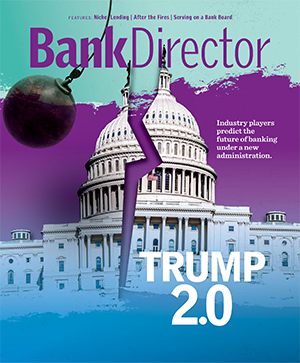Emily McCormick is Vice President of Editorial & Research for Bank Director. Emily oversees research projects, from in-depth reports to Bank Director’s annual surveys on M&A, risk, compensation, governance and technology. She also manages content for the Bank Services Program, including Bank Director’s Online Training Series. In addition to speaking and moderating discussions at Bank Director’s in-person and virtual events, Emily writes and edits for Bank Director magazine, BankDirector.com and Bank Director’s weekly newsletter, The Slant. She started her career in the circulation department at the Knoxville News-Sentinel and graduated summa cum laude from The University of Tennessee with a bachelor’s degree in Spanish and International Business.

Why Small Banks Dominate the Ranking
In 2025, Chris McComish expects his bank — $9.6 billion S&T Bancorp, headquartered outside Pittsburgh in Indiana, Pennsylvania — to cross over the $10 billion threshold. It’s an event McComish, S&T’s CEO, has been preparing for since taking the reins three years ago. “We run the company today like we’re a much bigger company,” he says. “I’m not doing my job if I’m not recognizing what the future looks like” and preparing for it.
Once that threshold is crossed, S&T will gain the Consumer Financial Protection Bureau as a regulator. Several regulatory requirements will kick in, including stress testing and compliance with the Durbin Amendment, which limits interchange income and impacts profitability. “You lose revenue, and you have additional regulatory costs,” says Kara Baldwin, a partner who leads the financial services audit group at Crowe LLP. Banks approaching the $10 billion line start preparing well in advance, beefing up operations, along with compliance staff and systems.
That means there are advantages to being a small, public bank, around $1 billion to $10 billion in assets. “There’s a small niche in the community banking space where you can optimize your asset size, where you’re getting the most bang for your buck,” says Damon DelMonte, a managing director at Keefe, Bruyette & Woods, who covers community banks.
Year after year, smaller banks dominate the top 25 list in Bank Director’s annual RankingBanking study, and this year has been no exception. Just six of the 25 best banks exceed $10 billion in assets, and of those only one, East West Bancorp, is above the $50 billion mark. The median asset size for this year’s ranking of top performers, sponsored by Crowe, totals just $5.8 billion — much smaller than more than $4 trillion JPMorgan Chase & Co., the biggest bank in the country, which ranked 128th overall and ninth in its asset class of banks over $50 billion. Last year, the median asset size for the top 25 banks was $4.3 billion.
A deeper dive into the data comprising the annual analysis — two profitability metrics, one asset quality and one capital metric— indicates consistent outperformance by small banks. Take ROAE, for example. Over the past three years, the top 30 banks in the below $5 billion asset category reported the highest ROAE every year; in 2023, that was 14.82%. In contrast, the top banks in the largest asset group have consistently reported the lowest ROAE — 12.24% in 2023.
The $10 billion mark isn’t the only explanation for outperformance by small banks. Some of the worst performers in this ranking, in fact, are also below $10 billion. Small banks still face high costs. They compete with the broader market for talent, and they’re investing in technology to keep pace with the industry. Funding costs can be a particular challenge. Smaller banks tend to pay higher rates to depositors than big banks do. In part, that’s because large banks can offer superior liquidity services in the form of ATMs, technological access and branch locations, so their customers agree to accept lower rates, according to an October 2023 working paper published by UCLA Anderson Review.
Therefore, small banks have disadvantages, too. The small banks that ranked highly in RankingBanking in the last few years exhibit discipline and strong balance sheet management, while dominating markets and enjoying loyal customers, which protects their net interest margin.
Wilson Bank & Trust — the banking subsidiary of Wilson Bank Holding Co. — might be the quintessential community bank. The Lebanon, Tennessee-based bank’s main branch and operations center are located right off Main Street, just a stone’s throw from city hall. Attend a community event or local football game, and you’re likely to see a Wilson Bank banner. Throughout the summer, staff hand out popsicles at county state fairs in middle Tennessee.
CEO John McDearman III calls Lebanon home; it’s where he grew up. He originally planned to be a dentist, he tells me, but banking was in his blood. “I watched my dad. I grew up seeing him as a local banker and seeing the impact he could make in the community,” he says. In 1994, he started working at NationsBank, eventually managing the bank’s Chattanooga office. He loved Chattanooga, but shortly after NationsBank merged to create Bank of America Corp. in 1998, he got a call. Wilson Bank wanted McDearman — who had lost his father to cancer — to come home. “I felt like God was opening a door,” he says. He became CEO in January 2020.
Lebanon is located just half an hour or so from Nashville in Wilson County, where the population has boomed. When Wilson Bank was founded in 1987, the county had half the residents it does today. In 2023, an estimated 164,000 called Wilson County home — an 11% increase in just three years, according to the U.S. Census Bureau, outpacing other counties surrounding Nashville. Wilson Bank holds 46% of the deposits in its growing Wilson County home base, according to the Federal Deposit Insurance Corp., far outpacing its nearest competitor, Nashville-based Pinnacle Financial Partners, with 13% of the market. Birmingham, Alabama-based Regions Financial Corp. holds 6% of the county’s deposits.
Over the decades, the bank has grown outside Wilson County’s borders deeper into middle Tennessee’s diverse communities, including Nashville, affluent Williamson County and rural DeKalb County. Wilson Bank expanded into the eastern half of the state with a loan production office in Chattanooga last year. Different markets have different needs — from well-heeled suburbs to more rustic outskirts. Keeping close ties to its communities helps Wilson Bank identify opportunities and adapt its approach in response to local nuances. And at $4.9 billion, McDearman believes Wilson Bank is the right size to fill gaps in the market that very small or very large banks won’t pursue.
“There’s plenty of opportunity for us,” he says. “We don’t try to be all things [to all people], but we do try to listen and tailor-fit individual situations.”
Meanwhile, depositors tend to stick with the bank. Wilson Bank’s cost of funds rose dramatically over the past year, from an average 0.5% in 2022 to 2.3% in 2023. Its net interest margin contracted slightly, to 3.3% from 3.7%. “We would rather pay our customers versus brokered deposits when possible,” says McDearman. Most of the bank’s deposits are homegrown, and he says it feels “really good” to reward savers with higher rates.
“I’ve been grateful for a balance sheet that’s resilient, that was built with a conservative nature over time,” says McDearman. That’s a balance sheet built on local retail customers and mom-and-pop small businesses — not several large depositors that could leave the bank in a pickle should those funds seek yield elsewhere. Those old-school depositors “are very sticky,” he says.
Exercising Discipline
Like Wilson Bank, many of RankingBanking’s top performers leverage relationships in their communities to enhance their balance sheet and grow. But it’s equally as important to balance flexibility with discipline in today’s increasingly uncertain, higher rate environment.
Mercantile Bank Corp., in Grand Rapids, Michigan, got its start as a commercial bank in 1997. The $5.6 billion bank placed among the top 25 banks in the RankingBanking study, coming in fourth largely due to high profitability — a 1.65% ROAA and 17.54% ROAE — and a low nonperforming asset ratio, at 0.08%. Mercantile is a business-focused lender with strong credit metrics, says DelMonte, who covers the stock. “They operate in very attractive markets,” he says. “There’s a lot of development going on and a lot of investment throughout those different communities” around Grand Rapids.
In addition to loans, primarily commercial real estate and commercial & industrial (C&I), Mercantile emphasizes getting a larger relationship with customers that creates more revenue streams, through services that generate noninterest income and create stickier deposits. These include more common bank services such as treasury management as well as payroll and human capital services — platforms that help customers hire and onboard employees, and manage benefits — which bank leaders see as a strategic differentiator.
But another surprising driver of noninterest income has been mortgage, says Raymond Reitsma, Mercantile’s CEO. “Even in this environment of relatively scarce housing inventory and relatively high rates, we continue to build our market share,” he says.
Mercantile saw an opportunity to grow its mortgage operation as brokers and financial institutions were scaling back. When other mortgage lenders let staff go, Mercantile hired them. In a higher interest rate environment, they’re putting in elbow grease by building relationships with real estate agents and developers. “You’re not getting the easy refinance call,” says Reitsma. “You need to find the person who actually found a house that they could buy and is ready to go. And that takes a lot of effort.”
Residential mortgage loan originations increased by 17% in 2023. That loan mix has shifted toward adjustable rate mortgages in the higher rate environment, according to Mercantile’s annual report. Those loans stay on balance sheet while fixed rate loans are sold.
Reitsma emphasizes discipline when he talks about the bank’s financial performance. “We can be very consistent across our organization, and what we do and how we do it,” he says. When Reitsma talks about discipline, he’s referencing adherence to the bank’s underwriting standards as well as its approach to asset/liability and capital management.
For example, it’s been more than a decade since the bank ended a quarter with a nonaccrual loan exceeding $1 million, says Mercantile Chief Financial Officer Charles Christmas. But it’s a tough time to be a commercial lender, with uncertainty hovering over CRE loans due to work-from-home trends and loans repricing at higher interest rates.
Not all CRE is in trouble, says Baldwin at Crowe. “It is tied to region; it’s tied to asset class,” she says. “And it’s tied to individual underwriting.” Lower loan-to-value ratios and personal guarantees make a big difference in assessing the quality of a bank’s CRE portfolio.
“Our borrowers are performing quite well,” says Reitsma. “The few that aren’t have more specific challenges. We’re trying to be very diligent to find those and deal with them, quickly and early.”
The Asset Sensitive Balance Sheet
Reitsma joined Mercantile two decades ago and became CEO in June after former CEO Robert Kaminski Jr. retired. In contrast, McComish joined S&T three years ago, as the bank was celebrating its 120th anniversary. It was a good time to revisit the bank’s vision, he says, renewing S&T’s emphasis on customer loyalty and employee engagement. “Our people are here to build relationships, and long-term relationships can translate into strong financial performance over time,” he says. He believes S&T can offer the same products and services as any of the big banks. But S&T — like many smaller banks across the country — has an advantage over larger competitors. “100% of my 1,300 employees live and work in the communities that we serve,” McComish says.
S&T operates 73 locations, and McComish and his executives regularly meet with bank staff across the bank’s Pennsylvania and Ohio footprint. The CEO has also recruited staff from other banks, says Dan Cardenas, a director and equity research analyst at Janney Montgomery Scott who covers S&T. “Chris has done a good job of bringing in people with bigger bank experience and improving areas within the organization that should get the company ready to grow.”
McComish has also been willing to try new approaches to deposit growth, using data analytics to better understand customer behavior and deposit flow trends. As depositors began to pursue yield in 2023, some — but not all — of their dollars left the bank. “We found a group of customers that moved some of their money out of the bank, but not all of their money out,” he says. S&T’s bankers wanted to win the full relationship back. “We believe we do a better job of serving customers than others; let’s put our money where our mouth is,” he says. “We had great success.”
But winning those clients back meant S&T paid a higher rate to depositors. Cost of funds rose from 0.3% at year-end 2022 to 1.6% a year later. But it helped that S&T was asset sensitive. In contrast to most of the industry, S&T’s net interest margin improved, from 3.8% to 4.1%, due to higher asset yields as loans and securities repriced, according to Cardenas. More than 40% of S&T’s loans have a floating rate, says McComish.
Meanwhile, Mercantile relied on wholesale deposits in its early days as a commercial bank. The bank has strengthened its core deposit franchise over the past decade, but with a loan-to-deposit ratio of 107%, there’s still room to grow deposits. Cost of funds grew from 0.5% in 2022 to 1.7% in 2023. Like S&T, its net interest margin grew despite this, from 3.3% to 4.1%, due to an asset sensitive balance sheet. The bank’s investment portfolio improved through 2023, with unrealized losses totaling $64 million compared to $83 million at the end of 2022. CFO Christmas attributes this improvement in part to maturities on some of the bank’s investments, which are all held as available for sale.
“It’s a matter of execution and getting the full relationship in the bank as we undertake the asset side growth,” says Reitsma. “Our goal is to grow the floating rate assets and the floating rate liabilities at the same rate and proportion, and on the fixed side, match the duration of our fixed rate assets and liabilities. If we do an appropriate job of pricing on both sides and match up the proportions and the durations, the margin takes care of itself.”
Mercantile’s executives are active managers of interest rate risk, leveraging flexible terms and swaps as needed. “We want to limit placing longer-term fixed rate loans on our balance sheet,” says Christmas.
Rising deposit costs have pressured the industry, particularly community banks. Concerns around CRE loans cast a pall over the sector — though many smaller banks’ exposure is generally limited to suburban areas and small towns with two- or three-story buildings that were less threatened by work-from-home trends, says Cardenas. He describes S&T’s office exposure, for instance, as “very manageable. Very little, if any, is in central business districts. They’re not lending to the people who build 50, 60-story skyscrapers. That’s just not what they do.”
And in many ways, what a bank won’t do could be as much of a differentiator for the small banks that dominate the top of RankingBanking, evidenced through disciplined underwriting and smart balance sheet management. There’s more than one way to successfully execute on the community banking model. But as Wilson Bank, S&T and Mercantile all demonstrate, community ties matter — coupled with executing on the fundamentals of banking and a dedicated focus to building deposit relationships through robust products and knowledge of their markets.
*This article has been updated to correct the spelling of Reitsma’s name and a slight change in the description of asset/liability management.



